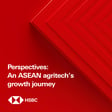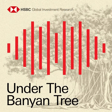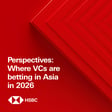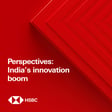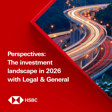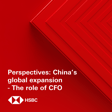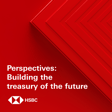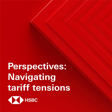Become a Creator today!Start creating today - Share your story with the world!
Start for free
00:00:00
00:00:01

The Macro Brief – Why AI, aircons and fridges are feeling the heat
In this edition, Amy Tyler and Sean McLoughlin talk about their research into the global cooling market and why the boom in artificial intelligence may complicate efforts to bring down CO2 emissions. Disclaimer: https://www.research.hsbc.com/R/101/gXDF9cF Stay connected and access free to view reports and videos from HSBC Global Research follow us on LinkedIn https://www.linkedin.com/feed/hashtag/hsbcresearch/ or click here: https://www.gbm.hsbc.com/insights/global-research.
Hosted on Acast. See acast.com/privacy for more information.
Transcript
Podcast Introduction
00:00:02
Speaker
Welcome to HSBC Global Viewpoint, the podcast series that brings together business leaders and industry experts to explore the latest global insights, trends, and opportunities.
00:00:13
Speaker
Make sure you're subscribed to stay up to date with new episodes.
00:00:16
Speaker
Thanks for listening.
00:00:17
Speaker
And now onto today's show.
China's Investment Climate
00:00:24
Speaker
Hello Macro Brief listeners, this is Harold van der Linde, Head of Asian Equity Strategy at HSBC and host of the Under the Banyan Tree podcast here in Hong Kong.
00:00:33
Speaker
On this week's podcast we're asking how global investors are feeling about putting their money in mainland China.
00:00:39
Speaker
It's been a pretty rough year on the Shanghai and Shenzhen markets, but are we now turning a corner?
00:00:45
Speaker
I put that question to our Head of Asia Research, Stephen Sun, who's just wrapped up a world tour of one-on-ones with major investors.
00:00:53
Speaker
Hope to see you under the banyan tree where we put Asian markets and economics in context.
00:00:59
Speaker
This podcast was recorded for publication on the 18th of April 2024 by HSBC Global Research.
00:01:05
Speaker
All the disclosures and disclaimers associated with it must be viewed on the link attached to your media player.
Environmental and Social Costs of Cooling
00:01:16
Speaker
Hello, I'm Peter Stegall in London.
00:01:18
Speaker
Welcome to the Macrobrief.
00:01:20
Speaker
This week I'm speaking to Amy Tyler from the Environmental, Social and Governance team and Sean McLaughlin, an equity analyst who leads our coverage of the European industrial sector.
00:01:31
Speaker
We'll be talking about their recent research into the environmental and social costs of keeping things cool as global temperatures rise.
00:01:38
Speaker
And of course, to identify the risks and opportunities for investors, because the cooling market, that's air conditioning and refrigeration, is worth about $270 billion in annual sales across residential, commercial, industrial and transport applications.
00:01:54
Speaker
Amy and Sean, welcome.
00:01:56
Speaker
Thank you for having us.
00:01:57
Speaker
Thank you.
Feedback Loop: Emissions and Cooling Demand
00:01:59
Speaker
So last year you examined the challenges of decarbonising heat across buildings and industries.
00:02:05
Speaker
This time you're looking at decarbonising cooling.
00:02:08
Speaker
I want to start with you, Amy, because you see the risk of a damaging feedback loop associated with the sector.
00:02:15
Speaker
What do you mean by that?
00:02:17
Speaker
So we rather ironically see cooling as a beneficiary from climate change, and this is because of the damaging feedback loop it creates.
00:02:25
Speaker
So this is where emissions from cooling, whether this is direct via refrigerants or indirect via the power source, contribute to global warming, which further increases cooling demand.
00:02:35
Speaker
So if we do look at some of the types of cooling, space cooling and refrigeration are the two primary cooling forms.
00:02:41
Speaker
Space cooling represents fans, air conditioners, dehumidifiers.
00:02:45
Speaker
These provide the thermal comfort, whereas the refrigeration keeps these goods at fixed temperatures.
00:02:50
Speaker
So that can include food and healthcare products.
00:02:53
Speaker
Now, there's one line in your report that really caught my eye.
00:02:56
Speaker
You say that artificial intelligence is driving increased demand.
00:03:00
Speaker
What's happening there?
00:03:02
Speaker
So we do see opportunity for cooling in data centres and AI.
00:03:06
Speaker
So this is because cooling is critical to data centres to prevent them overheating.
00:03:10
Speaker
So that regulates its temperature, airflow, humidity.
00:03:14
Speaker
And cooling does account for about 40% of a data centre's electricity consumption.
Cooling Demand Trends in China and India
00:03:19
Speaker
And with this expected rise in energy consumption of data centres, this is a bit of a concern for cooling emissions.
00:03:25
Speaker
The adoption of AI is a significant driver of energy consumption and cooling needs due to this greater workload and higher power chips, which then contribute more heat.
00:03:35
Speaker
If we do look at the global data centre cooling market, it's expected to grow threefold by 2030 and AI is this key driving force.
00:03:44
Speaker
In the report, you also mention a few other factors that are likely to underpin cooling demand.
00:03:49
Speaker
Can you talk us through a few of those?
00:03:52
Speaker
Yes, so the most fundamental driver of cooling is climate, specifically temperature and humidity.
00:03:58
Speaker
But for those experiencing hotter climates, it is commonplace to utilise air conditioning, whilst cooler regions can suffice with electric fans during hotter periods and heat waves, for example.
00:04:08
Speaker
So thermal comfort is crucial for everyone, but not everyone is able to experience cooling, whether this is affordability or access.
00:04:15
Speaker
And as regions develop growing populations and incomes, increases demand for cooling.
00:04:20
Speaker
So economic development increases urbanisation rates and often results in ageing populations, which do increase cooling demand further.
00:04:28
Speaker
And as access improves, cooling capacity grows.
00:04:32
Speaker
So Amy, you have this amazing statistic in the report that the use of electricity in China for cooling purposes increased 68 times between 1990 and 2016.
00:04:43
Speaker
That's a colossal increase.
00:04:45
Speaker
Yes, so China has seen a massive increase in cooling demand, very much in line with the economic development they've experienced.
00:04:51
Speaker
And other countries might see the same thing in the coming years, perhaps?
00:04:54
Speaker
Absolutely.
00:04:55
Speaker
India is definitely one to watch in terms of cooling demand as well.
00:04:59
Speaker
Now let's bring our Head of Industrials Research, Sean McLaughlin, into the conversation.
00:05:03
Speaker
So Sean, one of the areas the report focuses on is the difficulty associated with refrigeration and the so-called cold chain.
Energy-Intensive Cold Chain and Carbon Footprint
00:05:11
Speaker
What is the cold chain and what are these difficulties?
00:05:15
Speaker
Well, the coal chain is a network of specialist facilities and vehicles that transport perishable goods.
00:05:23
Speaker
So from the grower to the end consumer via air, via sea, via land.
00:05:31
Speaker
And it consists of the actual containers and trucks themselves, as well as the
00:05:39
Speaker
specialist infrastructure required and the planning also required to make sure that things remain at the ideal temperature.
00:05:47
Speaker
And we're seeing growth in the food and beverage industry as well as increasing use in pharmaceuticals.
00:05:55
Speaker
So think vaccines.
00:05:57
Speaker
So what's the sustainability aspect of this cold chain?
00:06:01
Speaker
Well, the coal chain is quite energy intensive.
00:06:04
Speaker
If you look across installed capacity in terms of gigawatts of cooling, the majority is in space cooling.
00:06:11
Speaker
But actually, most of the energy consumption happens on the refrigeration side.
00:06:17
Speaker
And the sustainability question going forward really is consumers may become more demanding of companies to ensure that they are not...
00:06:27
Speaker
buying into a polluted transport chain and we'd expect companies to come under more scrutiny about the carbon footprint associated with transporting cold goods.
00:06:40
Speaker
So let's take stock.
Improving Cooling Technology Efficiency
00:06:41
Speaker
Rising demand driven in part by data centres and in part just keeping the air conditioning on more and more as temperatures rise and there's this demand for more refrigeration as well.
00:06:51
Speaker
So how are industrial companies responding and where are the opportunities for investors?
00:06:57
Speaker
Yes, well, I'd say that the main thrust of where industrials can help with sustainability of cooling really comes down to the basic efficiency of the technologies.
00:07:11
Speaker
So we've seen a real increase in the basic efficiency of air conditioning units over the past decades through introduction of technologies like variable speed compressors, for example.
00:07:24
Speaker
And more and more we would expect efficiency to be a key driver of
00:07:32
Speaker
I think policy on one side and also on how companies maybe maintain a competitive advantage.
00:07:40
Speaker
Now, the risk of course is that if we do see a lot of emerging market growth in space cooling, then questions around efficiency and energy standards, is that going to actually increase a lot of emissions associated to cooling in these countries?
00:07:58
Speaker
So it's important from a company's perspective that they are driving the change.
00:08:03
Speaker
So a lot of new technologies entering the market.
00:08:08
Speaker
We also make the example of heat pumps, which is a very efficient way of creating heat and cooling with the same equipment.
Investment Opportunities in Cooling Technologies
00:08:18
Speaker
In the report, you also talk about overall electricity supply and how decarbonising that can help in decarbonising the cooling industry as well.
00:08:30
Speaker
So the rise of renewables must also be offsetting some of the consequences.
00:08:34
Speaker
Is that right?
00:08:35
Speaker
Well, yes.
00:08:36
Speaker
It's ultimately an assumption that...
00:08:40
Speaker
the sustainability of cooling also depends on the lowering of the carbon footprints in the power mix.
00:08:48
Speaker
So to give you a key stat from the report, 20% of global electricity consumption goes to cooling.
00:08:56
Speaker
So really, it is the, you know, how green is the electricity used that ultimately drives a greener cooling sector.
00:09:09
Speaker
So, I mean, we're talking about a huge market here.
00:09:12
Speaker
So presumably there are some big investment opportunities.
00:09:15
Speaker
Yes, indeed.
00:09:16
Speaker
And we've published a separate report that's looking at 20 stocks under coverage at HSBC that we think are exposed of beneficiaries of growth areas in cooling.
00:09:30
Speaker
And we break this down in broadly across four categories.
00:09:35
Speaker
The first and the largest is the supply chain.
00:09:39
Speaker
So think component suppliers from compressors to heat exchangers to actuators and valves.
00:09:45
Speaker
to appliance and system providers to some of the providers of specialist control systems to these appliances and systems.
00:09:57
Speaker
The second category is combined heating and cooling, so this specifically is heat pumps.
00:10:02
Speaker
The third category looks at passive cooling, so this is what you would put into building design to ensure better
00:10:11
Speaker
thermal performance of buildings and this ultimately boils down to insulation materials.
00:10:17
Speaker
And the fourth category is distributors and service providers of cooling.
00:10:23
Speaker
So some
District Cooling in the Middle East
00:10:24
Speaker
specialist
00:10:26
Speaker
cooling and refrigeration equipment distributors, as well as providers of services such as district cooling.
00:10:35
Speaker
So district cooling.
00:10:36
Speaker
Now, this really caught my eye in the report.
00:10:38
Speaker
How does it work?
00:10:39
Speaker
Well, district cooling, it's a business model that we're seeing emerging in the Middle East.
00:10:44
Speaker
And it really is, I guess it's the opposite of district heating.
00:10:48
Speaker
In other words, you're
00:10:51
Speaker
you're distributing cold air or water through a network of pipes to be able to cool a number of households or let's say indoor spaces at the same time.
00:11:04
Speaker
So Amy, if I can turn back to you, you touched on some of the social implications and the consequences of living on a hotter planet.
Impact of Rising Temperatures and Heatwaves
00:11:12
Speaker
What are some of the areas that concern you?
00:11:15
Speaker
Absolutely.
00:11:16
Speaker
So these rising temperatures, heat waves and droughts do pose the threats to people and their livelihoods.
00:11:22
Speaker
And we are increasingly reaching and exceeding some of these record temperatures with greater severity.
00:11:28
Speaker
And the share of the global population exposed to extreme heat has actually risen over the last four decades.
00:11:33
Speaker
This is from less than 60% to over 70%.
00:11:36
Speaker
And heat-related deaths have also been increasing alongside this.
00:11:40
Speaker
And on the policy front, what's happening?
00:11:42
Speaker
What sort of developments have we seen to help tackle this issue and break the feedback loop you've described?
00:11:47
Speaker
Yeah, so measures to improve access and the reliability of cooling equipment has been slow.
00:11:53
Speaker
But we have seen this global cooling pledge, which was introduced in December at COP28.
00:11:58
Speaker
And it does appear to be the first internationally coordinated policy to help counter these rising emissions.
00:12:04
Speaker
But we do think more is needed.
00:12:06
Speaker
The pledge does include targets such as emissions and access to sustainable cooling, and also average efficiency of new air conditioners, for example.
00:12:17
Speaker
This has been slow and we do expect better coordination globally, which is key to slowing some of these cooling emissions.
00:12:26
Speaker
Sean?
Global Efforts to Phase Out Polluting Refrigerants
00:12:27
Speaker
Well, thinking specifically of the refrigeration market, there's policy now...
00:12:33
Speaker
in Europe, in the US to phase out some of the more polluting refrigerants to substitute these with refrigerants that have a so-called lower global warming potential GWP.
00:12:48
Speaker
So we're talking about gases that contribute to the greenhouse effect, is that right?
00:12:53
Speaker
Correct.
00:12:53
Speaker
So, Sean, you mentioned that Europe and the US are leading the way in banning some of these refrigerants.
00:12:59
Speaker
Are other countries likely to follow?
00:13:01
Speaker
We certainly hope so.
00:13:02
Speaker
And I would expect that the global cooling pledge that we've had in COP28 is a signal of international willingness to tighten up on policy.
00:13:16
Speaker
Clearly more room for action then, and soon.
00:13:19
Speaker
Amy and Sean, thank you.
00:13:21
Speaker
Thank you.
00:13:21
Speaker
Thank you.
China's Economy and Currency Insights
00:13:22
Speaker
Three other takeaways and things to note in this edition of the Macrobrief.
00:13:27
Speaker
This week saw first quarter GDP from China rising by 5.3% year-on-year, exceeding expectations.
00:13:34
Speaker
The March data, according to our Greater China Economics team, was boosted by accelerations in manufacturing and infrastructure investment.
00:13:42
Speaker
Growth is on track to meet the government's target, but China's policymakers are still expected to roll out more support to sustain the momentum.
00:13:50
Speaker
Plus more clues coming up next week on the health of the global economy with April flash data from purchasing managers' indices on manufacturing and services.
00:13:59
Speaker
And finally, our latest edition of the Currency Outlook has just been published.
00:14:03
Speaker
The team still favours the US dollar on relatively high US yields and slow global growth.
00:14:09
Speaker
In this edition, we also take a closer look at the Japanese yen, the Chinese renminbi, gold and more.
00:14:16
Speaker
For more information on those reports, you can email us at askresearch at hsbc.com.
00:14:23
Speaker
That's all from the Macro Brief this week.
00:14:25
Speaker
Thanks for listening.
00:14:49
Speaker
Thank you for joining us at HSBC Global Viewpoint.
00:14:52
Speaker
We hope you enjoyed the discussion.
00:14:55
Speaker
Make sure you're subscribed to stay up to date with new episodes.
